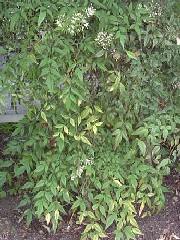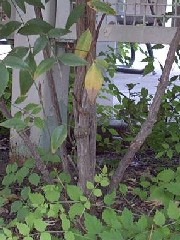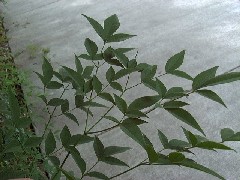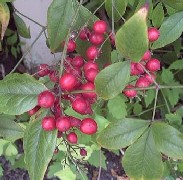Nandina, "Heavenly Bamboo"
Nandina domesticaFamily: Berberidaceae
Podcast Script
 Nandina domestica |
 Woody stem |
 Nandina Leaves |
 Summer berries |
Classification:
Angiosperm, Dicot, evergreenSize:
Can grow to about 5 to 8 ft. tall. Typically has a ground spread of roughly 2 to 3 ft.Identifying Features:
With lacy foliage and thin stems, the Nandina is most easily identified from season to season by the color of its leaves and berries. In the spring, bronzed-red leaves and bright white flowers draw eyes to its presence. In summer, the flowers are replaced by green berries and the leaves fades from blue-green to bright green. In fall, the leaves once again turn red but are accompanied by bright red berries.The leaves are in a compound, alternate arrangement. They are pointed oval leaflets up to 2 inches long.
Location/Habitat:
It is native to eastern Asia from the Himalaya east to Japan. However, it has become naturalized to North America. Naturally, it can be found growing in the southeastern states. Nandina does not grow in sand and thrives in rich soil.Flower/Fruit/Reproduction:
In spring, small clusters of white flowers are found among the leaves. The flowers are arranged in a loose terminal panicle. Both male and female parts are present in Nandina buds. By summer, the flowers turn into green berries which mature and turn bright red by autumn. The Nandina spreads its seeds through the berries which many animals eat and scatter.Water/Sun Requirements:
The Nandina is a very sturdy plant and can tolerate many different types of conditions. A versatile plant, it thrives in both sun and shade. However, it does best in an area that recieves morning sun and shade in the afternoons. In terms of how much water it needs, experts recommend a good soaking once a week. Nandina is prone to iron chlorises when overwatered.Special Adaptations:
During the winter, the Nandina drops all of its foliage and the plant dies down to the ground. However, as soon as Spring approaches, the plant "springs" back to life.Other Info:
- Classified as an "evergreen"
- Berries are poisonous if ingested
- Not a true bamboo
Reference Sources/Links:
Sources
This page was created by Kate W. 2007.